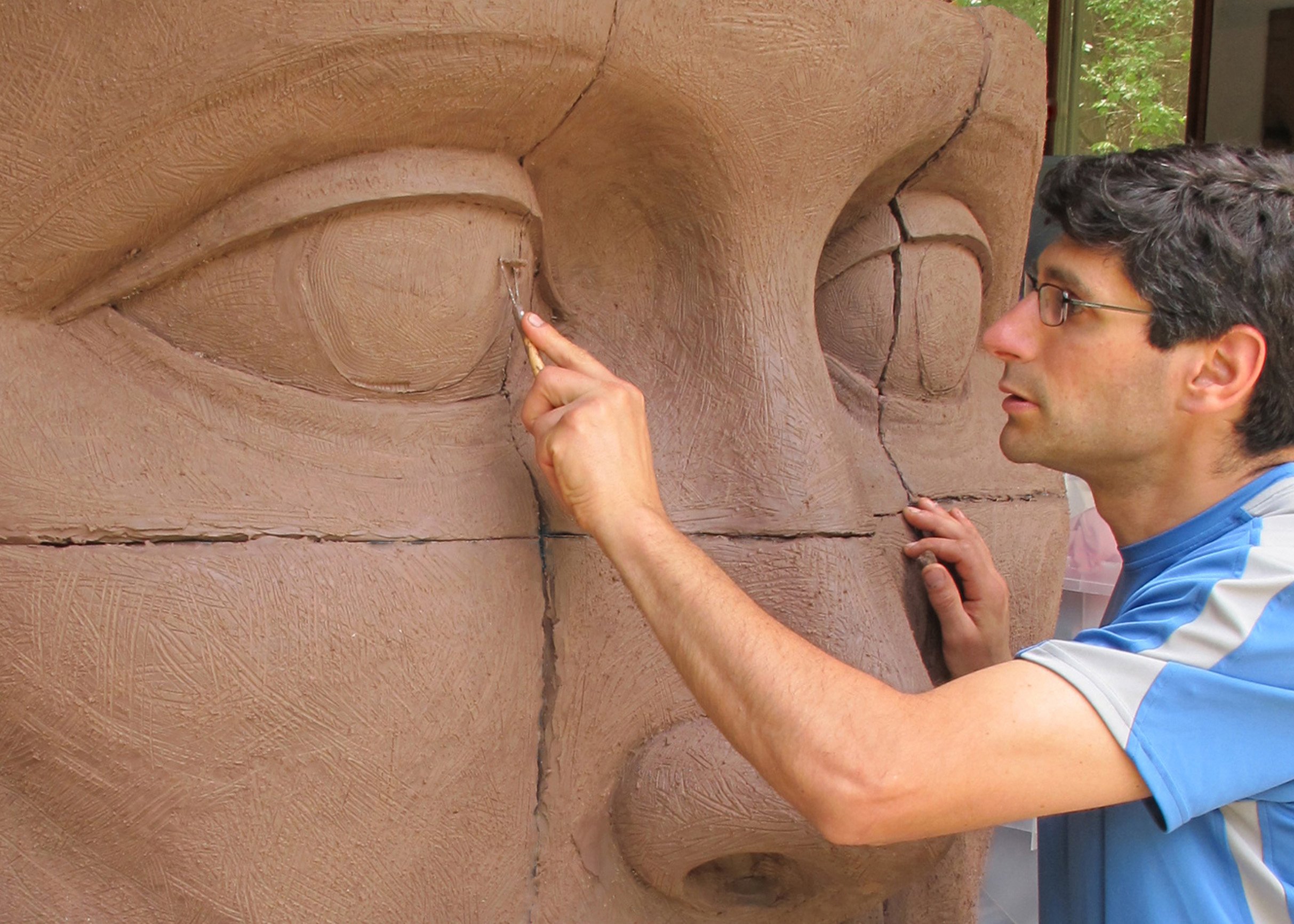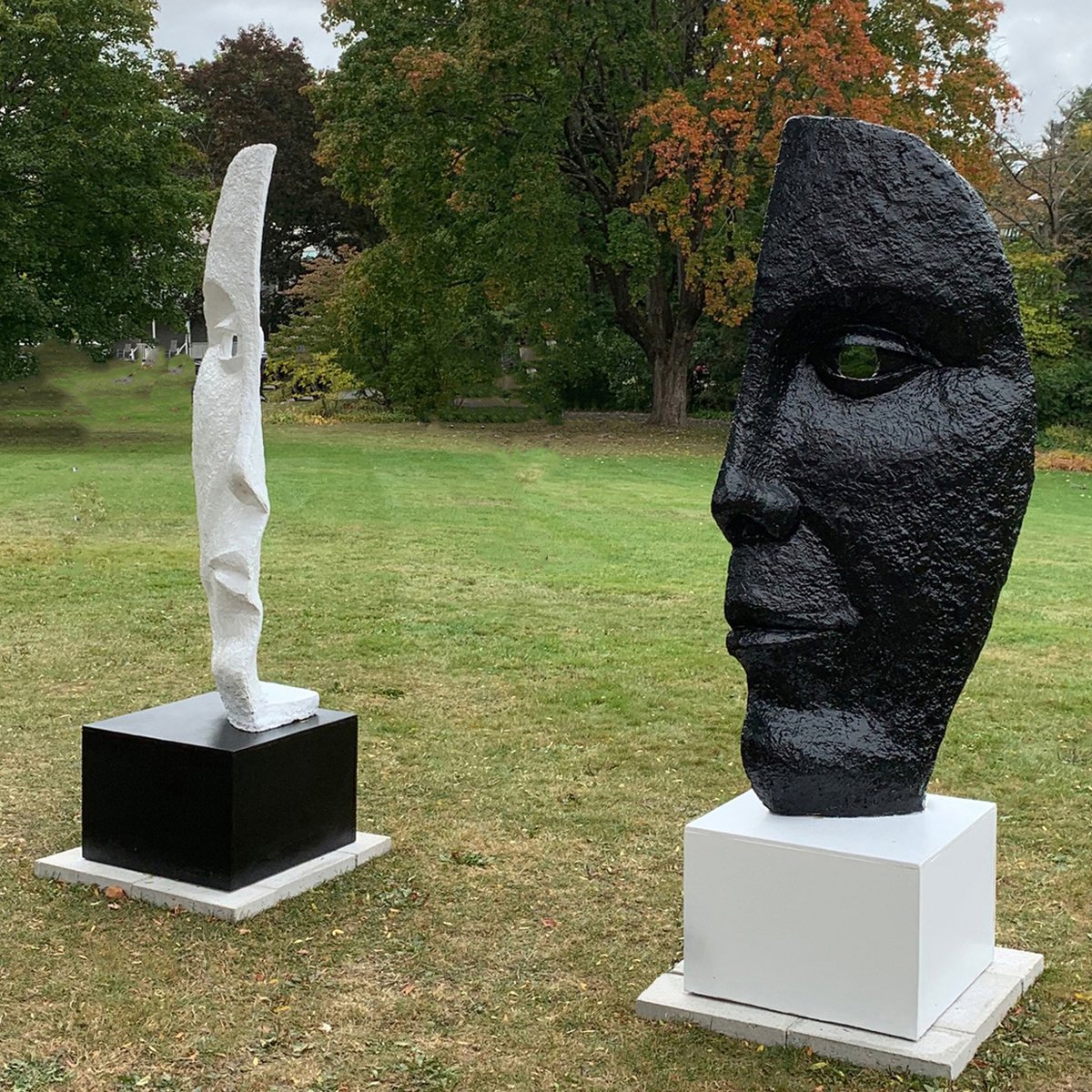A Invigorating Conversation with Michael Alfano
Headshot sculpting Cubed in clay - photo by Linda Chuss
A sculptor for over twenty-five years, Michael Alfano, creates fine art bronzes, portraits, and public work that is figurative-based and surrealistic. It goes beyond the literal, adapting the figure to convey philosophical ideas and abstract concepts. His sculptures are in galleries, private collections, parks, and museums worldwide.
“Of Many Minds” is a solo outdoor show with 20 sculptures along the Boston Waterfront Harborwalk; it opened in 2022 and will be on exhibit until December 2023. Michael has exhibited in cities including New York, Chicago, and Hilton Head. His most recent installation is Beacon, an 8-foot bronze, in downtown Brooklyn at Borough Hall. Some of his best-known pieces include The Holocaust Monument at the Jericho Jewish Center, NY; Journey, at the Zion Heritage Museum in Hyannis, MA, which commemorates contributions of African-Americans and Cape Verdeans on Cape Cod; One World United for Peace—September 11th Memorial, at Town Hill in Norfolk, MA, which was commissioned by the town, with a second casting in Clifton, NJ; Ethics of Peace at Georgetown University in Washington DC; and The Starter—George V. Brown, a life-size bronze at the start line of the Boston Marathon in Hopkinton, MA. He has recently completed sculptures of Economics Nobel laureate Milton Friedman and his wife Rose, which are life-size, full figures in bronze, at Capitaf, their foundation headquarters in VT, with a second one at Northwood University, MI. The Museum of Science, Boston, commissioned twenty-eight bronze life-size animals Michael made for their permanent collection.
I had the pleasure of asking Michael about some of the inspirations outside the art world, how he works with natural spaces when sculpting, and so much more.
UZOMAH: What made you want to become a sculptor?
MICHAEL: I primarily sculpt the face and the figure because that's what I’m drawn to do and to better get to know myself and human nature in a fundamental, nonverbal way. The over-life-size sculpted portrait captures and commands the attention of viewers. When I combine it with surrealist elements, it becomes a vehicle to convey intangible, philosophical concepts in a powerful way.
U: How would you explain how you make such life-like structures to someone who knows nothing about art and the 3D process?
M: I work in clay in a very traditional way, observing from the model or photos, using my own blend of oil-based clay mixed with wax and handmade tools to form the sculpture. Then, working with the foundry, we first make a mold and then cast the sculptures in bronze and other materials.
Questioning Mind - Bronze - 98” x 48” x 36”
“The important thing is to not stop questioning. Curiosity has its own reason for existing.” Albert Einstein
U: What things inspire you outside of the art world?
M: I live in the woods of central Massachusetts and spend a lot of time in the outdoors, just looking with wonder at the natural forms, from the canopy of the massive trees to the geometry of a rotting tree stump. I try to immerse myself within those forms.
Liquid Sunshine - Multimedia (painted aluminum, steel can) - 80” x 30” x 30”
“Turn towards the sun and all shadows will fall behind you.” Adapted from Charles Swain
U: How do you use natural spaces when planning a sculpture outdoors?
M: My primary concern with planning a sculpture display, whether outdoors or indoors, is how will viewers interact with the sculptures. What is their first impression? What is the viewer’s position or perspective as they physically approach it? What will they see from each angle? What are moments of discovery as they spend time with the sculpture? They walk around it, touch it, and read the title and the quote. What are they left thinking about? Is it an image that will remain embedded in their minds over time, pondering over and maybe changing their perspectives?
U: What is one thing about sculpting that someone would not think it has in it or is about?
M: One special aspect about sculpture is that people can physically touch and interact with the finished work, which you can’t do with a painting, or literature, or a performance.
Gates of Transcendence - Resin (black and white) – 72" x 72" x 24”
In Gates of Transcendence, the monumental face is split down the middle, with one-half black and the other white, conveying that the face of humanity includes all sides. The bases are the opposite colors of the sculptures they support, implying that any part of humanity relies on the other parts. The divisions do not represent struggle and opposition, but rather express a complementary unity.
U: How much research goes into each project?
M: It depends but can extend for months and months of reading, watching videos and looking at images, visiting a location, and discussing the engineering and technical aspects with the clients, foundry workers, and others.
U: What is your most essential tool as a sculptor, and why?
M: My most essential tools are my mind, creativity, and cultural experiences, such as a knowledge of diverse literature, music, art, philosophy, and science. Those form the framework my sculptures are built upon. The rest is the fabric my images are weaved through. Art is about a lot of things, but I feel it is primarily about communication.
Cosmic Vision - Bronze - 44" x 23 x 12”
“We are a way for the cosmos to know itself.” Carl Sagan
U: Often, your sculptures are made of bronze; what is the hardest part of using this material? Is it a material you prefer, and why?
M: Working in bronze is a long and arduous process, but the results can be spectacular, creating sculptures that can’t made with any other materials and almost glowing from within. There are bronzes that are more than 5,000 years old. It’s a way to make my mark on history during my lifetime and, hopefully, after I’m gone, to share with future generations something that spoke to ours.
U: What exercises do you do to keep your hands and arms in shape to create your sculpture?
M: Sculpting itself is very physically demanding, so just the act of doing it keeps all parts of me in shape.
Cubed, a 10 times life-size face in 9 pieces was the basis for “Not Eye, Us”, a performance created by the Continuum Dance Project for the Boston Center for the Arts in June 2023
U: Can you tell me about your most recent project combining sculpture and dance?
M: Not Eye, Us is an immersive performance in which the audience is on the stage and intermingles with the dancers and the sculpture. The sculpture is comprised of nine moveable pieces forming a face that appears female on one side and male, inverted, on the other side, with each piece pigmented in a different skin tone. Through manipulation of the pieces in the performance, Not Eye, Us examines individual diversity within a united community. This new cross-disciplinary dance challenges audiences to consider the impact of external perception on race and gender while empowering them to interact with, touch, and take ownership of the work.
In the performance and the talkback session, the audience becomes an integral part of the process, so much so that the work of art varies depending on the audience's participation. Not Eye, Us is not just the title but the underlying philosophical concept, in that the “Us” refers to everyone. The event creates a democratic environment where anyone can pick up the art, turn it around in their hands, and put it back in a different way, remaking the piece.
For more information about Michael’s work, please visit his site. Also, you can find information about his work on Instagram and Facebook.





